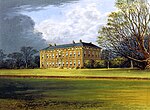River Nidd

The River Nidd is a tributary of the River Ouse in the English county of North Yorkshire. In its first few miles it is dammed three times to create Angram Reservoir, Scar House Reservoir and Gouthwaite Reservoir, which attract a total of around 150,000 visitors a year. The Nidd can overflow the reservoirs, flooding the caves in the valley. In such cases the river overflows into the normally dry river bed past Lofthouse through to Gouthwaite Reservoir. The Yorkshire Dales Rivers Trust YDRT has a remit to conserve the ecological condition of the River Nidd from its headwaters to the Humber estuary. The upper river valley, Nidderdale, was designated as an Area of Outstanding Natural Beauty in 1994.
Excerpt from the Wikipedia article River Nidd (License: CC BY-SA 3.0, Authors, Images).River Nidd
The Avenue,
Geographical coordinates (GPS) Address Nearby Places Show on map
Geographical coordinates (GPS)
| Latitude | Longitude |
|---|---|
| N 54.014166666667 ° | E -1.2188888888889 ° |
Address
The Avenue
YO26 8ES
England, United Kingdom
Open on Google Maps











